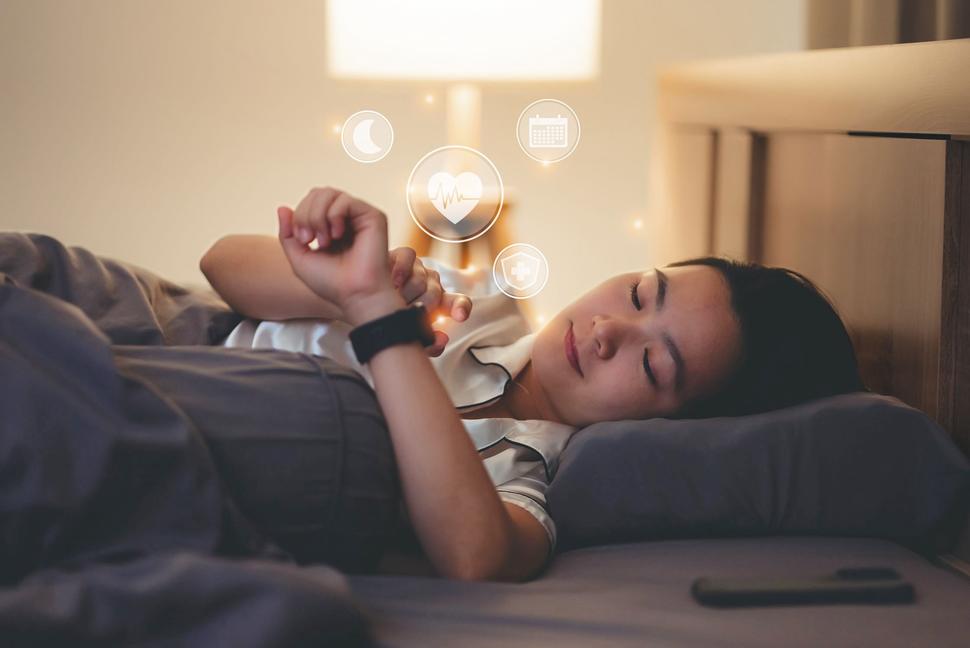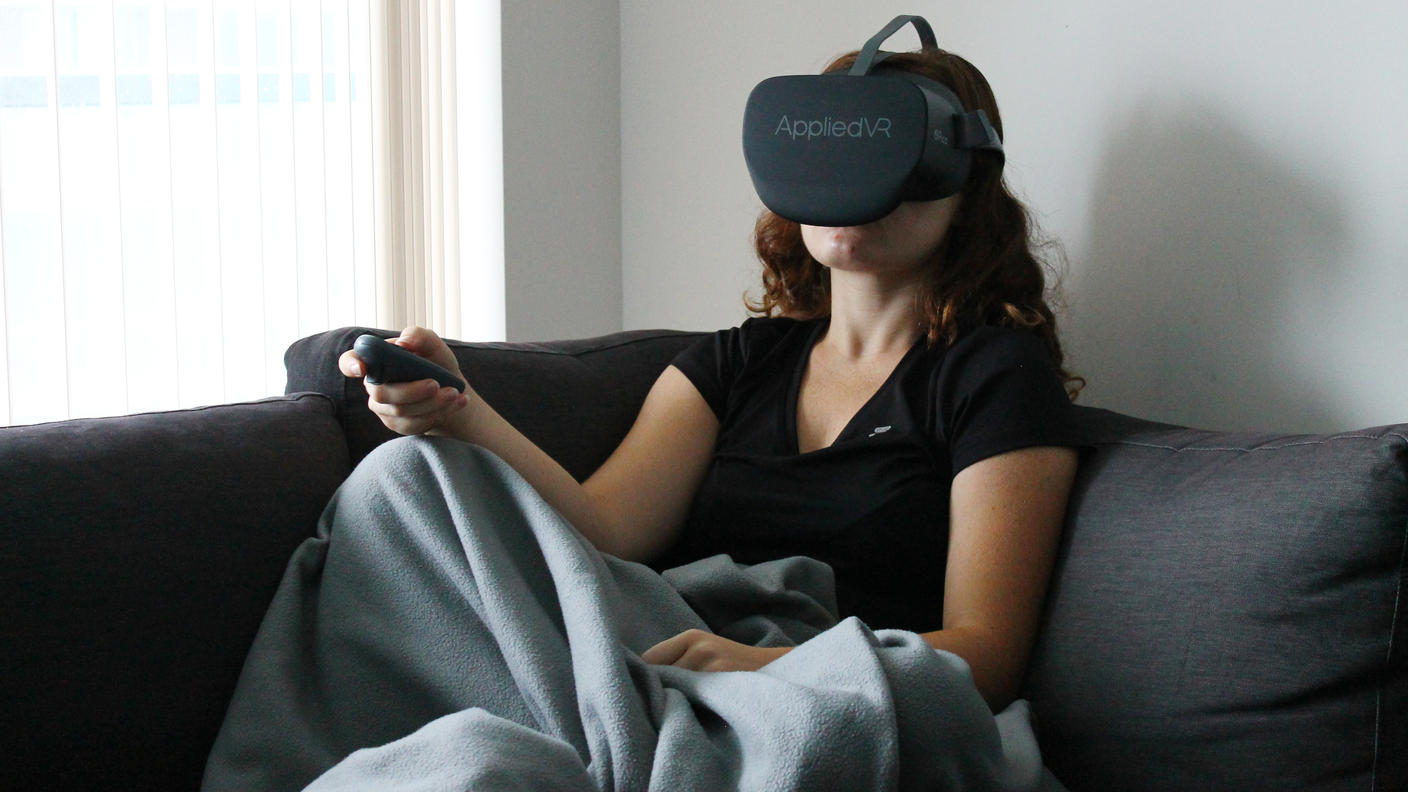Smart Wearables Show Promise for Tracking Sleep Patterns in Brain Tumor Patients
, by Raleigh McElvery, Neuro-Oncology Branch Scientific Communications Editor
An interim study analysis demonstrates that combining Fitbit data with self-assessments is a reliable method for understanding sleep changes in patients.
People with primary brain tumors often experience debilitating symptoms, which can impact their quality of life and how they respond to treatment. Nearly one in five patients experience altered sleep patterns that make daytime functioning difficult. These sleep disturbances also increase the risk of developing anxiety and depression.
Researchers in the lab of Terri Armstrong, Ph.D., at the NCI Center for Cancer Research’s Neuro-Oncology Branch (NOB) are devising ways to monitor patients’ sleep over long time periods. They are leading an observational study using a smart wearable device called a Fitbit to measure sleep, heart rate, and activity patterns. They also combined these physiological measurements with participants’ self-assessments.
The researchers recently demonstrated the feasibility and reliability of this approach in an interim analysis published in Neuro-Oncology Practice. They hope their work will help identify which brain tumor patients are vulnerable to developing sleep issues—and prompt more targeted interventions to address these problems.
“Sleep disturbance is pervasive across the neuro-oncology population,” Dr. Armstrong says. “We noticed this in the clinic many years ago, which spurred us to conduct extensive lab work examining the biological underpinnings of this phenomenon. With this clinical study, we’re taking what we learned at the lab bench and bringing it back to the bedside to help patients.”
Bench to Bedside and Back Again
In 2017, Dr. Armstrong’s lab devised the first mouse model replicating the daytime sleepiness that many brain tumor patients experience due to radiation treatment. Former NOB Postdoctoral Fellow Dorela Shuboni-Mulligan, Ph.D., led this preclinical work and was instrumental in initiating the new clinical study.
“We found a simple, cost-effective way to collect high quality sleep data, and the participants really enjoyed it,” says Dr. Shuboni-Mulligan, now an assistant professor of pathology and anatomy at Eastern Virginia Medical School. “It was also gratifying to see many of the same trends we’d observed in our preclinical models reflected in people.”
A cloud-based platform called Fitabase allowed the researchers to monitor the data collection in real time. Without providing any personally identifiable information, participants could control their accounts via a mobile app and authorize which data the researchers could see.
The interim analysis examined the first 54 people enrolled in the study. Over the course of four weeks, participants wore their Fitbits for most of the day and night, only removing the watches to charge. They also completed a series of self-assessments (often called patient-reported outcomes). During the final week, they maintained a daily sleep diary.
The researchers were very pleased with how closely most participants followed the study protocol. Seventy-two percent wore their Fitbits for the entire study duration, and 100 percent completed all the self-assessments.
Maeve Pascoe, M.D., a former NIH Medical Research Scholars Program Fellow, helped patients join the study. She would also reach out to them if they weren’t wearing and charging their watches.
“The adherence to the study design was staggering,” says Dr. Pascoe, now a neurology resident at the University of Michigan. “Dr. Armstrong’s group is very good at implementing outcomes measures and interacting with patients. As the study progressed, we had to remind fewer and fewer people to wear their watches. This bodes well for the feasibility of future studies—and shows just how motivated our patients are.”
An Unexpected Benefit
Although the study was purely observational—the researchers were not testing new treatments—the participants received a surprising benefit. More than 10 percent experienced fewer sleep disturbances at night and less sleep-related impairment during the day. The researchers suspect this was because people were engaging with their own sleep data and changing their behaviors as a result. For example, if your Fitbit indicates you have a sleep deficit from the night before, you may be more likely to go to bed early the next day.
Those who reported sleep disturbances at night also tended to have more fragmented sleep: After going to bed, they would wake up periodically. As Dr. Shuboni-Mulligan explains, these issues could signal that cancer treatment or other factors may be affecting patients’ circadian rhythms.
People may be more or less susceptible to sleep disturbances depending on whether they are “morning larks” who are active early in the day or “night owls” who spring to life at night. Thirty-nine percent of study participants identified as morning larks, while only 6 percent identified as night owls. The rest fell somewhere in between.
Dr. Armstrong’s previous research showed that brain tumor patients who carry a genetic mutation associated with morning larks are often protected against the daytime sleepiness caused by radiation treatment. By contrast, in the general cancer population, night owls tend to have worse treatment outcomes. As a result, understanding when a person is most active during the day could signal if they will develop sleep disturbances during treatment. However, before making any predictions, researchers must account for other factors (such as age) that could affect whether someone is a morning or an evening person, Dr. Shuboni-Mulligan says.
Using Tech Devices to Improve Outcomes
The researchers, led by Clinical Staff Scientist Amanda King, Ph.D., are eager to see what else they will uncover as the study progresses and they work toward their goal of enrolling 160 participants. They are also continuing to address potential limitations. (For example, the Fitbit has trouble differentiating between naps and meditation.)
The team is also spearheading additional efforts to address patient symptoms, including a clinical study using virtual reality to ease anxiety and depression, and a free app to track symptoms and self-care activities.
“We are lucky to be working with such amazing patients,” Dr. Pascoe says. “They really love contributing to science and are extremely driven to improve care and treatment for others with brain tumors.”

